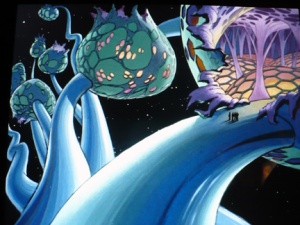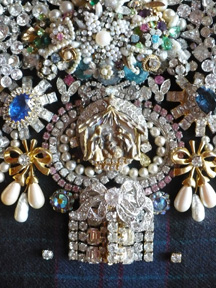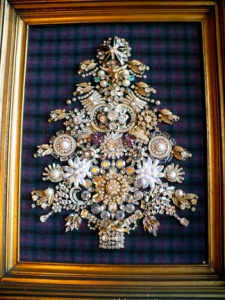It never occurred to me, through years of watching my daughters’ enthusiastic application of glow-in-the-dark stars to their entire bedroom ceilings (with sticky putty), Peace Frog and 90s retro Flower Power stickers to their doors, mobiles made and hung, posters and bulletin boards on the walls (with surprise! industrial-strength Velcro), that someday it would all have to come down. The process has been daunting, equal parts emotion and elbow grease, but having my nose inches from the details while getting this house ready for sale has given me a new appreciation for some of the changes I’ve made.
 When I first walked into the front hallway of this Indiana house, I knew immediately it was The One. I grew up in a 150-yr-old Queen Anne Victorian house in Rhode Island so the dentil moldings, framed and capped doorways, and stained glass inserts felt familiar. The previous owners built the house to recreate a Vermont inn they loved and maybe I got a subconscious New England vibe. The first floor’s rooms are all connected (perfect for parties) and the light is amazing. I never noticed that there was no shower in the (carpeted!) master bathroom and, more importantly, no bookcases. But the house had good bones and, over the years, it’s morphed to further reflect my New England sensibilities.
When I first walked into the front hallway of this Indiana house, I knew immediately it was The One. I grew up in a 150-yr-old Queen Anne Victorian house in Rhode Island so the dentil moldings, framed and capped doorways, and stained glass inserts felt familiar. The previous owners built the house to recreate a Vermont inn they loved and maybe I got a subconscious New England vibe. The first floor’s rooms are all connected (perfect for parties) and the light is amazing. I never noticed that there was no shower in the (carpeted!) master bathroom and, more importantly, no bookcases. But the house had good bones and, over the years, it’s morphed to further reflect my New England sensibilities.
Bookcases in mantels. This is my favorite design accident. After building more  traditional corner bookcases in my bedroom and installing bookcases in the study, I discovered Salvage One in Chicago. They used to have an entire floor of mantels in various states of disrepair stacked 10-deep along the walls. It was heaven; I bought four of them for $50 apiece and refinished them myself. One was installed in the dining room to masquerade as a real fireplace and the others went to each daughter’s room. Instant coziness! However, one daughter
traditional corner bookcases in my bedroom and installing bookcases in the study, I discovered Salvage One in Chicago. They used to have an entire floor of mantels in various states of disrepair stacked 10-deep along the walls. It was heaven; I bought four of them for $50 apiece and refinished them myself. One was installed in the dining room to masquerade as a real fireplace and the others went to each daughter’s room. Instant coziness! However, one daughter  didn’t like the empty darkness of the mantel’s interior at night so I filled the center space with a bookcase. Presto, no more night fears! I loved the look and gave the other mantels the same treatment—a perfect union of practicality and visual interest.
didn’t like the empty darkness of the mantel’s interior at night so I filled the center space with a bookcase. Presto, no more night fears! I loved the look and gave the other mantels the same treatment—a perfect union of practicality and visual interest.
Painted floor. The cost of refinishing the worn hardwood in the kitchen prompted me to paint it with Benjamin Moore Porch & Deck enamel instead. After 15 years, it still looks pretty good.
kitchen prompted me to paint it with Benjamin Moore Porch & Deck enamel instead. After 15 years, it still looks pretty good.
Pocket doors. My house has a Jack-and-Jill bathroom—a bathroom centered between two bedrooms and accessible to both  by doors inside each room. The hinged doors required an awkward amount of clearance to open fully in such a small space. Pocket doors make the bathroom feel larger; they perform the same miracle in the master bath where access to a closet was a problem.
by doors inside each room. The hinged doors required an awkward amount of clearance to open fully in such a small space. Pocket doors make the bathroom feel larger; they perform the same miracle in the master bath where access to a closet was a problem.
Interior windows. The same Jack-and-Jill bathroom had no natural light and I avoid overhead lights if I can. A small  window punched into the wall from one of the bedrooms makes the area much more friendly to use. Another small window brings natural light from a bedroom into a closet (once used as a nursery) and several salvaged stained glass windows in the basement bridge the finished and unfinished sections.
window punched into the wall from one of the bedrooms makes the area much more friendly to use. Another small window brings natural light from a bedroom into a closet (once used as a nursery) and several salvaged stained glass windows in the basement bridge the finished and unfinished sections.
Beadboard and other wainscoting. Wherever it was needed. To 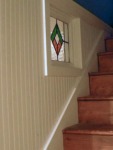 paraphrase Betty White’s Mrs. Bickerman in Lake Placid, blank walls haunt me so.
paraphrase Betty White’s Mrs. Bickerman in Lake Placid, blank walls haunt me so.
Built-in mirror. The builder-basic mirror in the master bath covered an entire wall. I asked a brilliant finish carpenter if it was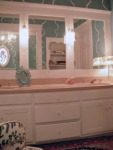 possible to cut the mirror into thirds and frame it in; he took it as a challenge and did a fantastic job. Now it looks as though it’s been there forever.
possible to cut the mirror into thirds and frame it in; he took it as a challenge and did a fantastic job. Now it looks as though it’s been there forever.
I hope this house inspires its next owner as it has me. Most everything I did can be easily restored—any parts I removed were put in the basement (just in case I ever changed my mind). I learned so much working on this house, inside and outside, and look forward to more problem-solving design opportunities on my next adventure.





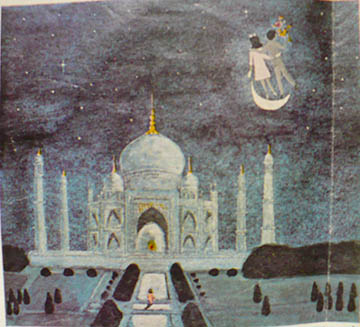

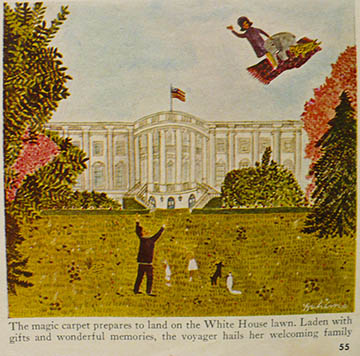

 When I first walked into the front hallway of this Indiana house, I knew immediately it was The One. I grew up in a 150-yr-old Queen Anne Victorian house in Rhode Island so the dentil moldings, framed and capped doorways, and stained glass inserts felt familiar. The previous owners built the house to recreate a Vermont inn they loved and maybe I got a subconscious New England vibe. The first floor’s rooms are all connected (perfect for parties) and the light is amazing. I never noticed that there was no shower in the (carpeted!) master bathroom and, more importantly, no bookcases. But the house had good bones and, over the years, it’s morphed to further reflect my New England sensibilities.
When I first walked into the front hallway of this Indiana house, I knew immediately it was The One. I grew up in a 150-yr-old Queen Anne Victorian house in Rhode Island so the dentil moldings, framed and capped doorways, and stained glass inserts felt familiar. The previous owners built the house to recreate a Vermont inn they loved and maybe I got a subconscious New England vibe. The first floor’s rooms are all connected (perfect for parties) and the light is amazing. I never noticed that there was no shower in the (carpeted!) master bathroom and, more importantly, no bookcases. But the house had good bones and, over the years, it’s morphed to further reflect my New England sensibilities. traditional corner bookcases in my bedroom and installing bookcases in the study, I discovered Salvage One in Chicago. They used to have an entire floor of mantels in various states of disrepair stacked 10-deep along the walls. It was heaven; I bought four of them for $50 apiece and refinished them myself. One was installed in the dining room to masquerade as a real fireplace and the others went to each daughter’s room. Instant coziness! However, one daughter
traditional corner bookcases in my bedroom and installing bookcases in the study, I discovered Salvage One in Chicago. They used to have an entire floor of mantels in various states of disrepair stacked 10-deep along the walls. It was heaven; I bought four of them for $50 apiece and refinished them myself. One was installed in the dining room to masquerade as a real fireplace and the others went to each daughter’s room. Instant coziness! However, one daughter  didn’t like the empty darkness of the mantel’s interior at night so I filled the center space with a bookcase. Presto, no more night fears! I loved the look and gave the other mantels the same treatment—a perfect union of practicality and visual interest.
didn’t like the empty darkness of the mantel’s interior at night so I filled the center space with a bookcase. Presto, no more night fears! I loved the look and gave the other mantels the same treatment—a perfect union of practicality and visual interest. kitchen prompted me to paint it with Benjamin Moore Porch & Deck enamel instead. After 15 years, it still looks pretty good.
kitchen prompted me to paint it with Benjamin Moore Porch & Deck enamel instead. After 15 years, it still looks pretty good. by doors inside each room. The hinged doors required an awkward amount of clearance to open fully in such a small space. Pocket doors make the bathroom feel larger; they perform the same miracle in the master bath where access to a closet was a problem.
by doors inside each room. The hinged doors required an awkward amount of clearance to open fully in such a small space. Pocket doors make the bathroom feel larger; they perform the same miracle in the master bath where access to a closet was a problem. window punched into the wall from one of the bedrooms makes the area much more friendly to use. Another small window brings natural light from a bedroom into a closet (once used as a nursery) and several salvaged stained glass windows in the basement bridge the finished and unfinished sections.
window punched into the wall from one of the bedrooms makes the area much more friendly to use. Another small window brings natural light from a bedroom into a closet (once used as a nursery) and several salvaged stained glass windows in the basement bridge the finished and unfinished sections. paraphrase Betty White’s Mrs. Bickerman in Lake Placid, blank walls haunt me so.
paraphrase Betty White’s Mrs. Bickerman in Lake Placid, blank walls haunt me so. possible to cut the mirror into thirds and frame it in; he took it as a challenge and did a fantastic job. Now it looks as though it’s been there forever.
possible to cut the mirror into thirds and frame it in; he took it as a challenge and did a fantastic job. Now it looks as though it’s been there forever. My great-grandmother’s deep-seated comfy chair is more than 100 years old; since plucking it from my grandmother’s basement when I went off to grad school, it’s moved with me for another 30. My grandmother had it upholstered in a nubby brown cotton in the 1940s and nothing’s been done for it since. Always the most comfortable chair in the house (if not the most lovely), I’ve kept it in my bedroom. Lately, with the laser-sharp awareness of imperfection one develops when getting a house ready for sale, I had to accept that the chair’s shabbiness had progressed beyond the standard considered chic. The fabric was tearing off the chair frame’s top edge and worn down to the cotton batting on the arms; the feather cushions had lost their oomph. In a burst of inspired procrastination equal to the one that brought the chair to this sorry state in the first place, I put aside the packing and cleaning to give my comfy chair an overdue intervention.
My great-grandmother’s deep-seated comfy chair is more than 100 years old; since plucking it from my grandmother’s basement when I went off to grad school, it’s moved with me for another 30. My grandmother had it upholstered in a nubby brown cotton in the 1940s and nothing’s been done for it since. Always the most comfortable chair in the house (if not the most lovely), I’ve kept it in my bedroom. Lately, with the laser-sharp awareness of imperfection one develops when getting a house ready for sale, I had to accept that the chair’s shabbiness had progressed beyond the standard considered chic. The fabric was tearing off the chair frame’s top edge and worn down to the cotton batting on the arms; the feather cushions had lost their oomph. In a burst of inspired procrastination equal to the one that brought the chair to this sorry state in the first place, I put aside the packing and cleaning to give my comfy chair an overdue intervention.








